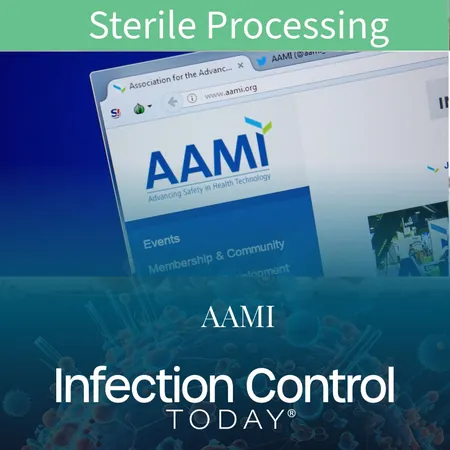
Revolutionary Update in Medical Device Sterilization: AAMI TIR17:2024 Sets New Standards
2025-03-24
Author: Rajesh
Material compatibility in sterilization represents a crucial hurdle for medical device manufacturers and sterile processing experts. As the integrity of medical products and their packaging can’t be compromised, ensuring safety without sacrificing functionality has never been more urgent. In light of this challenge, the Association for the Advancement of Medical Instrumentation (AAMI) has announced the release of its updated guidance document, AAMI TIR17:2024, focusing on the compatibility of materials subject to sterilization.
This significant revision sheds light on how different sterilization techniques—ranging from ethylene oxide (EO) to vaporized hydrogen peroxide—affect a variety of materials, including polymers, ceramics, and metals. With a strong emphasis on scientific data, the new document provides exhaustive guidance on material selection, processing methods, testing protocols, and aging programs that are essential for maintaining device safety.
As of January 16, 2025, this latest edition of TIR17 has received official recognition from the FDA, which has added it to its Recognized Consensus Standards Database alongside three other AAMI sterilization guidance documents. These include: - **ANSI/AAMI ST24:2024**: Guidelines for general-purpose ethylene oxide sterilizers with automated process control in health care facilities. - **ANSI/AAMI ST58:2024**: Protocols concerning chemical sterilization and high-level disinfection in healthcare environments. - **AAMI TIR106:2024**: Standards for microbiological methods and the understanding of product bioburden data.
In a conversation with **Infection Control Today**, Dr. Jami McLaren, co-chair of AAMI’s working group behind TIR17 (STWG96) and a sterility assurance fellow at Boston Scientific, elaborated on the practical implications of TIR17's update, the rationale behind it, and its potential impact on patient safety and sterilization science.
The Need for Revision
Dr. McLaren explained that AAMI Technical Information Reports (TIRs) typically undergo automatic revision every three years. Recognizing discrepancies and areas needing enhancement, the working group focused on streamlining information regarding accelerated aging and updating guidance on assessing material compatibility in light of new sterilization modalities.
Scientific Rigor
An informal survey revealed that the material compatibility annexes in previous revisions were often referenced but contained subjective and inconsistent information. Consequently, this latest update has revamped these tables with rigorous criteria for compatibility ratings, based on peer-reviewed literature, historical usage data, the presence of known degradation pathways, and relevant white papers. This ensures material ratings are standardized and traceable, offering invaluable insight for manufacturers.
Navigating Challenges
Manufacturers are constantly challenged by the need to ensure that new products can be effectively sterilized without losing functionality. Understanding the interaction between materials and sterilization methods is fundamental, particularly as devices grow increasingly complex and new sterilization techniques emerge. This knowledge helps mitigate risks associated with lost hours and resources in design iterations.
Material Compatibility Expansion
The updated TIR now includes compatibility ratings for 70 common materials used in the medical device industry. This enhanced catalog helps manufacturers make informed choices during the design phase by providing relevant data regarding how these materials respond to various sterilization conditions.
Updated Aging Programs
Furthermore, the revised document features clearer guidelines on accelerated aging programs, aligning them more closely with material compatibility assessments. This aids in developing testing plans based on risk assessment and real-world data, ensuring that older products remain compliant as standards evolve.
Future Implications
Overall, the revised material compatibility ratings and guidance provided by AAMI TIR17:2024 equip device designers with critical tools to navigate sterilization challenges effectively. As the industry shifts towards more advanced sterilization methods, adopting these updates may significantly influence standards and practices, ensuring that the devices are not only safe but also reliable in delivering patient care.
The release of AAMI TIR17:2024 is poised to be a game-changer, shaping the future landscape of sterilization practices in the medical device industry. Will your products stand the test of these new standards? The answer may determine the future of patient safety and device efficacy!


 Brasil (PT)
Brasil (PT)
 Canada (EN)
Canada (EN)
 Chile (ES)
Chile (ES)
 Česko (CS)
Česko (CS)
 대한민국 (KO)
대한민국 (KO)
 España (ES)
España (ES)
 France (FR)
France (FR)
 Hong Kong (EN)
Hong Kong (EN)
 Italia (IT)
Italia (IT)
 日本 (JA)
日本 (JA)
 Magyarország (HU)
Magyarország (HU)
 Norge (NO)
Norge (NO)
 Polska (PL)
Polska (PL)
 Schweiz (DE)
Schweiz (DE)
 Singapore (EN)
Singapore (EN)
 Sverige (SV)
Sverige (SV)
 Suomi (FI)
Suomi (FI)
 Türkiye (TR)
Türkiye (TR)
 الإمارات العربية المتحدة (AR)
الإمارات العربية المتحدة (AR)